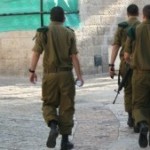 For years, Palestinian protests have been held in the West Bank, and despite not escalating to serious armed violence by the protesters, they have nonetheless resulted in the injuries of more than 200 Israeli security personnel in the last two years. In recent months, Palestinian leaders have repeatedly called for nonviolent protests as part of their upcoming bid for statehood at the United Nations. Yet when those protests could involve not hundreds—but thousands—of Palestinians, it’s easy to see why the IDF is not taking chances that the protests will remain peaceful.
For years, Palestinian protests have been held in the West Bank, and despite not escalating to serious armed violence by the protesters, they have nonetheless resulted in the injuries of more than 200 Israeli security personnel in the last two years. In recent months, Palestinian leaders have repeatedly called for nonviolent protests as part of their upcoming bid for statehood at the United Nations. Yet when those protests could involve not hundreds—but thousands—of Palestinians, it’s easy to see why the IDF is not taking chances that the protests will remain peaceful.
In light of the potential for protests to threaten Israelis, the IDF is preparing with additional training and the acquiring of a significant amount of nonlethal riot dispersal equipment. IDF spokeswoman Lt. Col. Avital Leibovich, in an interview by phone with The Mideast Update, said that the first main principal to the IDF preparation is a directive to maintain restraint.
“The soldiers were directed to act with the utmost restraint, because we are aware of the fact there are civilians [that will be present],” said Leibovich. She noted that despite the possibility that there could be armed persons among those civilians, “we do not want to take extra risks dealing with the civilians.”
The second principal element to the IDF preparation is to increase the capability of the military to handle riot dispersal—which Leibovich notes is “not a usual role” for the IDF. Along those lines, Leibovich said they have purchased “a great amount” of varying riot dispersal means.
These include tear gas, 20 vehicles with water canons, and loud speakers. Leibovich emphasized the means are non-lethal and will only be used if Palestinians threaten Israeli civilians or security personnel.
“When the [protests] will be calm and quiet and will stay inside the city-centers of the Palestinians, we will not intervene,” said Leibovich. “But if there will be a threat, either to Israelis, or to the lives of the soldiers or the other security personnel, we will then start to use those means in a very measured way in order to try and disperse the riot.”
Furthermore, even when the IDF is forced to engage with nonlethal riot dispersal, Leibovich said they are set to escalate their use of the dispersal equipment in stages. So a lighter form of riot dispersal would be used initially, followed by a more intense nonlethal means if things continued to escalate.
The IDF has learned from past experience, including those years of riots in the West Bank. Leibovich said that of the more than 200 injuries to security personnel stemming from the riots, some of the injuries were severe, including the loss of eyes.
In light of that specific risk, the IDF is providing masks to protect the faces of soldiers, especially from stone-throwing. “A rock can kill and cause severe wounds,” notes Leibovich.
In addition to learning from ongoing West Bank protests, the IDF also learned from the major and violent border protests from earlier this year. In those, mass numbers of Syrians attempted to storm Israel’s northern border, resulting in breaches of the border. The protests escalated to the point of some protesters being killed as Israel defended their sovereign border from violent protesters from a hostile nation.
Leibovich said that lessons from the border protests were “implemented in the training of the IDF soldiers.”
Despite all the preparation and readiness, however, the IDF wants to see the next couple months pass peacefully. Said Leibovich, “Overall we are prepared, but we do hope for a quiet September and October, and for [protests] that will remain within the borders of the Palestinian cities.”
(By Joshua Spurlock, www.themideastupdate.com, September 7, 2011)
